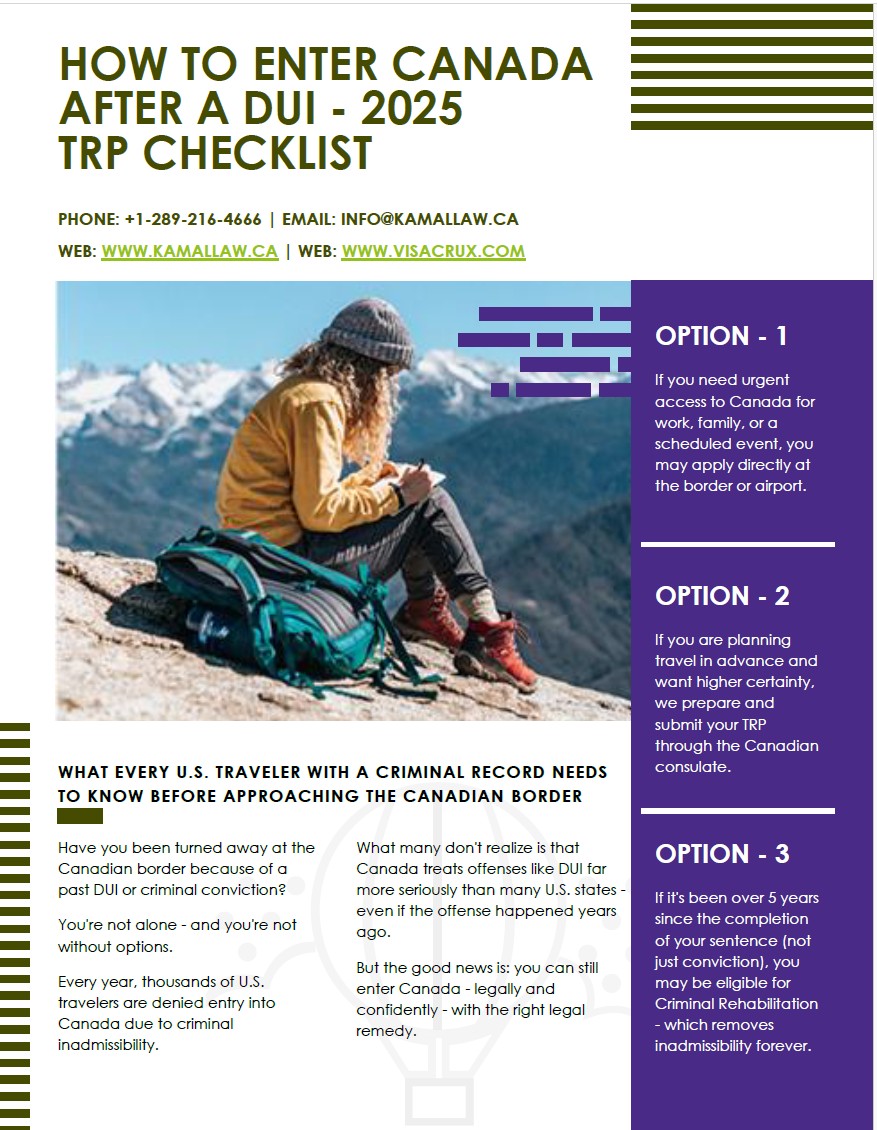How to Get into Canada with a DUI (2025 TRP & Criminal Rehabilitation Guide)

How to Get into Canada with a DUI: Assessing Your Criminal History Before Travel
By Kamal Akhtar, Canadian Immigration Lawyer | Last Reviewed: August 17, 2025
1. TRP and Criminal Rehabilitation
2. Temporary Resident Permit (TRP)
3. Criminal Rehabilitation
4. How to Enter Canada with a DUI
5. TRP for DUI (Driving Under the Influence)
6. TRP Checklist 2025 (Free PDF Download)
To get into Canada following a DUI arrest can resemble navigating a complex legal system. Many Americans, U.S. citizens, and people from other countries are shocked to learn that even a single DUI conviction can make them criminally inadmissible under Canadian law. Whether you are traveling for vacation, work, or family emergencies, your criminal record can become an unexpected barrier at the Canadian border.
A misdemeanor DUI or old misdemeanor in the United States may seem minor, but under Canadian immigration authorities, it is often treated as an equivalent crime, a serious criminal offense that triggers criminal inadmissibility. This means Canadian border agents or Canadian border officials can deny entry to foreign nationals, even if they only have DUI charges without jail time.
If your trip involves international travel for a specific purpose, such as a business meeting or a family event, being turned away at the border can disrupt your plans and cause significant stress. Thankfully, the Government of Canada provides both a temporary solution, like a Temporary Resident Permit, and a permanent solution, the criminal rehabilitation application, that allow you to enter Canada legally.

Kamal Akhtar is a Canadian immigration lawyer licensed by the Law Society of Ontario. Based in Ontario, Canada. Kamal has years of experience helping foreign nationals with immigration applications and appeals. He specializes in Canadian immigration law and other complex entry solutions. Kamal dedicates himself to delivering honest, strategic, and client-centered legal solutions for every case.
USA Phone: +1 (289) 216-4666 | Fax: +1 (289) 778-4745 | Email: info@kamallaw.ca
This comprehensive 2025 guide will cover the following topics:
- Why DUI offenses lead to criminal inadmissibility
- How to assess your criminal history before traveling
- Temporary and permanent solutions for entry
- Step-by-step application process for TRP and rehabilitation
- Legal advice and lead generation tips for a smooth experience
Why a DUI Leads to Criminal Inadmissibility
Canada is strict about border security and Canadian society's safety. Canadian immigration officials evaluate every criminal conviction on your criminal record to determine whether it qualifies as criminal inadmissibility.
Under Canadian law, many DUI offenses are considered a serious criminal offense or serious criminality. This includes:
- Influence of alcohol while operating a motor vehicle
- Influence of drugs resulting in dangerous driving
- Reckless driving if linked to substance impairment
- Felony conviction for repeat or aggravated dui offenses
Even a single conviction, like a single DUI conviction, can trigger criminal inadmissibility. This is because immigration officers and the Canada Border Services Agency (CBSA) assess the maximum penalty for the equivalent crime in Canada, not the U.S. classification.
Example Scenario
Imagine John, an American citizen, received a misdemeanor DUI in Florida five years ago. Under U.S. law, the offense was a minor traffic violation, and he completed probation with no jail time.
However, under Canadian immigration authorities, the crime is considered an indictable offense with a maximum penalty of 10 years. If John arrives at a Canadian port of entry without a temporary resident permit or criminal rehabilitation application, Canadian border agents may refuse him entry for posing a potential risk to Canadian society.
The Role of Time in Canadian Immigration Decisions
Time is a critical factor when dealing with criminal inadmissibility. The passage of time, sometimes referred to as the virtue of time, can affect whether a traveler qualifies for automatic deemed rehabilitation or grandfathered deemed rehabilitation.
- Automatic deemed rehabilitation occurs in rare cases when a long time has passed since a single conviction, and the offense is no longer considered a major potential risk.
- Grandfathered rehabilitation may apply for old laws or old DUI cases before Canadian legislation tightens.
However, travelers should not rely solely on the virtue of time. Legal advice and legal assistance from a Canadian immigration lawyer are strongly recommended to determine if you qualify for individual rehabilitation or need a temporary solution like a TRP.
Assessing Your Criminal History Before Travel
Before planning your trip, review your criminal history to avoid unpleasant surprises at the Canadian border.
Step 1: Review Your Record
Check for:
- Past DUI conviction or single DUI conviction
- Multiple dui offenses or felony convictions
- Any criminal charges that could qualify as a similar offense in Canada
If your arrest history includes such convictions, you may need a temporary resident permit or criminal rehabilitation application.
Step 2: Collect Your Documentation
Having the necessary documentation ready is essential:
- Court documents for all criminal convictions
- Proof of jail time, probation, or fines served
- Arrest history and application process notes for prior travel
Travelers risk immediate denial at the Canadian border if they fail to carry court documents and arrest history, as immigration officers and Canadian border agents require proof that their sentence is complete.
Step 3: Determine Your Travel Purpose
Canadian immigration authorities are more likely to approve entry if you have a specific purpose or valid reason for travel, such as
- Visiting family (holidays, weddings, emergencies)
- Attending work meetings for business travelers
- Academic or professional conferences
- Medical appointments or compassionate visits
Applicants with specific travel dates and clear reasons are less likely to be seen as a potential risk to Canadian society.
Practical Example
Sarah, a foreign national from the U.S., had DUI charges in 2018 and completed probation in 2019. She wants to attend her sister’s wedding in Toronto.
Because only five years have passed since her criminal conviction, she is not yet eligible for criminal rehabilitation application approval. Her best option is a temporary solution: applying for a Temporary Resident Permit for that specific travel date. With legal opinion letter support, she may enter Canada.
Temporary Solution: Temporary Resident Permit (TRP)
When your criminal history includes DUI offenses, entering Canada without proper authorization is risky. A Temporary Resident Permit (TRP) is often the best temporary solution for foreign nationals who need to enter Canada for a specific purpose before they qualify for a criminal rehabilitation application.
A TRP allows Canadian border agents and the Canada Border Services Agency (CBSA) to grant you special permission to enter Canada despite your criminal inadmissibility. It’s typically issued for a specific travel date or specific reason, making it ideal for:
- Business travelers attending urgent meetings or conferences
- American citizens visiting family in emergencies
- International travel for weddings, funerals, or medical care
- Rare cases where travel is time-sensitive and denial would cause hardship
Canadian immigration officials assess whether granting a TRP poses any potential risk to Canadian society. They evaluate the criminal record, including your arrest history, court documents, and whether your criminal charges involved serious criminality or a serious criminal offense.
When You Need a TRP
You need a Temporary Resident Permit if:
- You have a single DUI conviction, old DUI, or misdemeanor DUI
- You have dui charges or criminal convictions that are considered similar offense under Canadian law
- Your waiting period for individual rehabilitation or automatic deemed rehabilitation has not yet passed
Without a TRP, Canadian border officials may refuse entry, especially if:
- Court documents are missing
- Criminal history shows multiple dui offenses
- Potential risk to Canadian society is perceived
Step-by-Step TRP Application Process
Applying for a TRP involves a careful application process. Here’s how to do it:
Step 1: Determine Eligibility
Check if you meet these criteria:
- Your criminal record is resolved (no ongoing criminal charges)
- Your specific purpose for entry is valid
- Your travel date is urgent or important enough to justify special permission
Scenario Example:
Michael, an American citizen, has a past DUI conviction from 2020. He’s invited to present at a corporate event in Vancouver. Since only four years have passed, he doesn’t yet qualify for a criminal rehabilitation application, but his business traveler status with a valid reason makes him eligible for a TRP.
Step 2: Gather Necessary Documentation
To increase approval chances, prepare all necessary documentation:
- 1. FBI and state records
- 2. Court documents proving completion of jail time, probation, or fines
- 3. Arrest history showing your old misdemeanor or old DUI is fully resolved
- 4. Legal opinion letter from a Canadian immigration lawyer for legal assistance
- 5. Supporting evidence of specific reason for travel (conference invite, medical letter, wedding invitation)
Canadian immigration authorities and immigration officers want to see that your application process is thorough and that you pose no potential risk.
Step 3: File the TRP Application
You can submit your TRP request in two ways:
- 1. Canadian consulate in the United States (recommended)
- 2. Canadian port of entry at the border (for rare cases requiring urgent entry)
Filing at the border can be faster but riskier. Canadian border agents have full discretion to deny entry if they believe the criminal history or arrest history indicates a serious criminal offense.
Step 4: Demonstrate Low Risk
To convince Canadian border officials to approve your TRP, emphasize:
- Virtue of time since your criminal conviction
- That your criminal history involves a single conviction or old DUI
- Your specific purpose and valid reason for travel
- That you have taken steps toward rehabilitation and no longer pose a potential risk
Scenario Example:
Emma, a foreign national with DUI charges from 2015, applies for a TRP to attend her father’s funeral in Montreal. She includes:
- FBI and state records
- Court documents proving her sentence was completed
- A legal opinion letter supporting urgent humanitarian entry
- A death certificate as her specific reason
The CBSA immediately grants her a Temporary Resident Permit (TRP) due to her demonstrated compelling need and low risk.
Step 5: Receive the TRP and Travel
If approved, your Temporary Resident Permit allows entry for the duration of the specific travel date or trip. Keep in mind:
- This is a temporary solution only
- You must reapply for future trips until your criminal rehabilitation application is approved
- Some TRPs are single-entry, while others may cover multiple entries within their validity period
Pros and Cons of a Temporary Resident Permit
Pros:
- ✅ Allows international travel without waiting for rehabilitation
- ✅ Can be issued quickly for specific purpose trips
- ✅ Provides a bridge solution during waiting period
Cons:
- ❌ Temporary solution, does not erase criminal inadmissibility
- ❌ Must reapply for each new trip
- ❌ Approval is discretionary and often requires legal representation
TRP Tips for Success
- 1. Always include a legal opinion letter: Canadian immigration lawyer support dramatically improves approval chances.
- 2. Be honest about your arrest history: Canadian border agents can access FBI and state records.
- 3. Show necessary documentation: Missing court documents is the top reason for denial.
- 4. Emphasize your valid reason: Weddings, business events, and medical emergencies carry weight.
- 5. Understand border security priorities: Officers protect Canadian society, so demonstrate low risk.
Permanent Solution: Criminal Rehabilitation Application
While a Temporary Resident Permit (TRP) is an excellent temporary solution, travelers seeking a permanent solution must apply for criminal rehabilitation. Once your criminal rehabilitation application is approved by the Government of Canada, you will no longer be considered criminally inadmissible, and you can enter Canada freely for international travel without repeated TRP applications.
Eligibility for Criminal Rehabilitation
To qualify for individual rehabilitation, certain conditions must be met:
1. Enough time has passed since your criminal conviction
- At least five years since completing jail time, probation, or fines
- The waiting period begins after all sentences are fully served
2. Your criminal history is stable
- A single conviction or single DUI conviction is easier to resolve
- Multiple dui offenses or felony convictions may still qualify with strong legal representation
3. You pose no potential risk to Canadian society
- No new criminal charges or arrest history since your past DUI conviction
- Virtue of time demonstrates responsible behavior
Scenario Example:
David, an American citizen, received DUI charges in 2017, completed probation in 2018, and has no further criminal history. In 2025, David has completed the waiting period and submits a criminal rehabilitation application to attend his daughter’s graduation in Canada.
Because he has a specific purpose and enough time has passed, he is a strong candidate for approval.
Step-by-Step Criminal Rehabilitation Application Process
Applying for criminal rehabilitation requires careful planning and necessary documentation. Here’s how to complete the application process:
Step 1: Determine Eligibility
- Confirm that at least five years have passed since completing all penalties.
- Check for automatic deemed rehabilitation or grandfathered deemed rehabilitation if you have an old DUI or old misdemeanor.
- Determine if your offense qualifies as a similar offense or equivalent crime under Canadian law.
Step 2: Gather Necessary Documentation
Your application must include:
- 1. Court documents for all criminal convictions and such convictions
- 2. Arrest history from local, state, or FBI sources
- 3. Proof of sentence completion (including jail time, probation, fines)
- 4. Legal opinion letter from a Canadian immigration lawyer to strengthen your case
- 5. Evidence of virtue of time and lack of potential risk to Canadian society
Tip: Missing necessary documentation is one of the most common reasons immigration officers refuse applications.
Step 3: Submit the Application
- Submit to Citizenship Canada or the nearest Canadian consulate.
- Ensure the application process is complete and signed.
- If you are using legal representation, include your legal opinion letter to enhance credibility.
Step 4: Wait for Processing
The waiting period for a criminal rehabilitation application is typically 6–12 months but can be longer in rare cases.
During this long time, if you must travel for a specific reason, you can still apply for a temporary resident permit to bridge the gap.
Benefits of Criminal Rehabilitation
- ✅ Permanent solution – travel without restrictions
- ✅ Removes the potential risk designation from Canadian immigration authorities
- ✅ No longer need TRPs for every trip
- ✅ Facilitates smoother border security checks
Traveling to Canada During the Waiting Period
While your criminal rehabilitation application is in process:
- You remain criminally inadmissible until approved
- You must apply for a Temporary Resident Permit for each specific travel date
- Carry all necessary documentation, including court documents and arrest history
Canadian border agents and immigration officers will assess:
- Whether you have a valid reason or specific purpose for entry
- If your criminal history involves serious criminality or serious criminal offense
- Your potential risk to Canadian society
Scenario Example:
Linda, a foreign national with a past DUI conviction, applies for criminal rehabilitation in January 2025. She must attend her sister’s wedding in July. She files a TRP with her legal opinion letter, explaining her specific purpose and valid reason. Canadian border officials approve the TRP while her criminal rehabilitation application is pending.
Professional Legal Assistance
Working with a Canadian immigration lawyer provides several advantages:
- A legal opinion letter that strengthens your application process
- Step-by-step legal advice for TRP and rehabilitation
- Free consultation to determine if you qualify for automatic deemed rehabilitation or need individual rehabilitation
- Higher approval chances due to decades of experience in similar criminal record cases
Many applicants fail due to missing court documents, incomplete arrest history, or misunderstanding Canadian immigration authorities’ expectations. Legal assistance helps prevent costly mistakes.
6. Common Questions (FAQs)
Can I enter Canada with a single DUI conviction?
Can I enter Canada with a single DUI conviction?
A: Yes, but you need a temporary resident permit or criminal rehabilitation application to avoid refusal at the Canadian border.
Does an old DUI still make me inadmissible?
Does an old DUI still make me inadmissible?
A. Yes, unless virtue of time qualifies you for automatic deemed rehabilitation under old laws or grandfathered deemed rehabilitation.
Can I apply for a TRP at the border?
Can I apply for a TRP at the border?
A: Yes, in rare cases. However, Canadian border officials may deny entry without a legal opinion letter or clear valid reason.
What documents do I need?
What documents do I need?
A: You need court documents, arrest history, and all necessary documentation proving completion of your sentence.
How long does criminal rehabilitation take?
How long does criminal rehabilitation take?
he waiting period is usually 6–12 months, but rare cases may take longer.
What is the difference between TRP and criminal rehabilitation?
What is the difference between TRP and criminal rehabilitation?
- TRP = Temporary solution for specific travel date
- Criminal rehabilitation = Permanent solution that clears your criminal inadmissibility
Who should apply for legal assistance?
Who should apply for legal assistance?
Anyone with DUI charges, a felony conviction, or an old misdemeanor should seek legal advice for the best outcome.
Key Takeaways
- A single DUI conviction, old DUI, or DUI offense can make a U.S. citizen inadmissible.
- Temporary solution: TRP for urgent or specific purpose trips.
- The permanent solution involves submitting a criminal rehabilitation application after a specified waiting period.
- Always prepare necessary documentation and consider legal representation.
- Canadian immigration authorities and the Canada Border Services Agency prioritize border security and Canadian society safety.
Where to Find Resources?
To stay updated with the latest rules and regulations, application processes, forms, and other details about Canada temporary resident permit TRP or rehabilitation, consider visiting this government website: Temporary resident permits (TRPs).

Kamal Akhtar is a Canadian immigration lawyer licensed by the Law Society of Ontario. Based in Ontario, Canada. Kamal has years of experience helping foreign nationals with immigration applications and appeals. He specializes in Canadian immigration law and other complex entry solutions. Kamal dedicates himself to delivering honest, strategic, and client-centered legal solutions for every case.
Kamal's credentials include a Bachelor of Law (LL.B.) and a Master of Law (LL.M.) from Osgoode Hall Law School in Toronto. Kamal is a noted member of professional associations like the Canadian Immigration Lawyers Association (CILA), the Canadian Association of Professional Immigration Consultants (CAPIC), the Canadian Bar Association (CBA), and the Ontario Bar Association (OBA). Over 20 years of legal experience shape Kamal's insights.
Please note that the information provided on this website does not constitute legal or professional advice.
Phone: +1 (289) 216-4666 | Fax: +1 (289) 778-4745 | Email: info@kamallaw.ca



